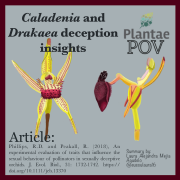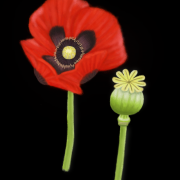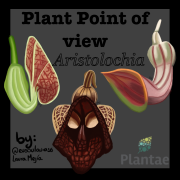Plant Point of View: Orchids
This series is the exploration of plants that are notable for various reasons: e.g., by producing specialized metabolites, by illuminating evolution, by serving as genetic models, or by their contributions towards practical applications.
Orchids
The orchid family (Orchidaceae) is the second largest plant family, comprising nearly 1000 genera. In this highlighted (open access) review article from Amy Hinsley and collaborators, orchid conservation and trade is the focus. First, we have to recognize that this family is very diverse in forms, colors and scents so very important for horticulture. Some orchids are used in traditional foods; for example, in Turkey the drink salep uses 35 species of orchid tubers in the preparation including Anacamptis spp., Dactylorhyza spp. and others), and in Zambia, chikanda is a cake-like snack made from tubers of Disa, Satyrium and Habenaria. Traditional Ayurvedic and Chinese medicine systems also include the use of orchid extracts.
These applications intersect with the global orchid trade in two ways. The good one adheres to international and national legislation and international trade rules. The bad one involves illegal trade, where the orchids are collected excessively until they are over harvested and may become extinct. Orchid enthusiasts sometimes buy rare, endangered, or endemic plants from sellers that bypass CITES (Convention on International Trade in Endangered Species of Wild Fauna and Flora) regulations.
In this fine review, the authors discuss strategies to prioritize conservation of these plants including the need to gather more information about the illegal harvest and its implications, the need to strengthen the legal trade of orchids, and the need to raise awareness of the importance of orchid conservation to the public as well as policy makers.

Hinsley A., de Boer, H.J., Fay, M.F., Gale, S.W., Gardiner, L.M., Gunasekara, R.S., Kumar, P., Masters, S., Metusala, D., Roberts, D.L., Veldman, S., Wong, S., and Phelps, J. (2018) A review of the trade in orchids and its implications for conservation. Botanical Journal of the Linnean Society 186: 435–455, https://doi.org/10.1093/botlinnean/box083
 Laura Alejandra Mejía is a biologist, MSc pharmaceutical sciences from Universidad Nacional de Colombia, and a 2019 Plantae Fellow. My main interests are plant biology, application of plant metabolites, and the creation and dissemination of science for the public. You can follow me on Twitter @Eusoulaura16 and Instagram: @eusoulaura16.
Laura Alejandra Mejía is a biologist, MSc pharmaceutical sciences from Universidad Nacional de Colombia, and a 2019 Plantae Fellow. My main interests are plant biology, application of plant metabolites, and the creation and dissemination of science for the public. You can follow me on Twitter @Eusoulaura16 and Instagram: @eusoulaura16.








